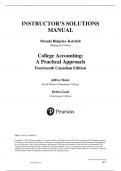Exam (elaborations)
Solution Manual For College Accounting A Practical Approach 14th Canadian Edition 2023 ISBN : 9780135222416 By Jeffrey Slater , Debra Good Complete Guide A+
- Course
- Institution
- Book
Solution Manual For College Accounting A Practical Approach 14th Canadian Edition 2023 ISBN : 9780135222416 By Jeffrey Slater , Debra Good Complete Guide A+ 1 Accounting Concepts and Procedures: An Introduction ANSWERS TO DISCUSSION QUESTIONS AND CRITICAL THINKING/ETHICAL CASE 1. The function...
[Show more]



